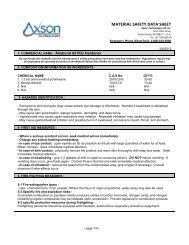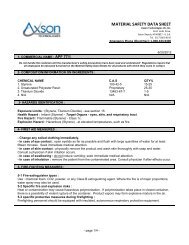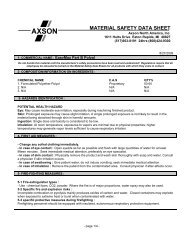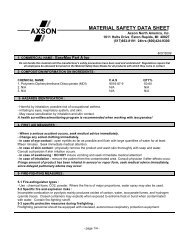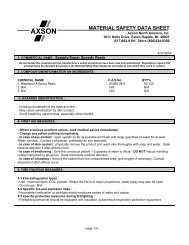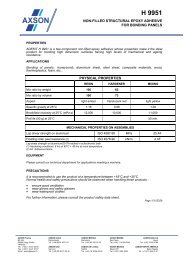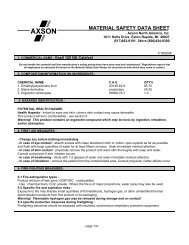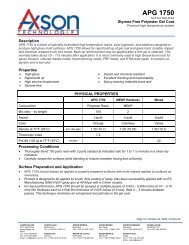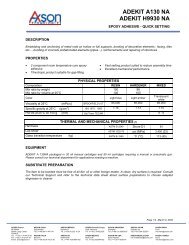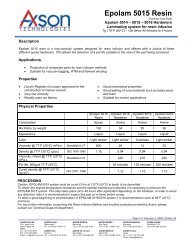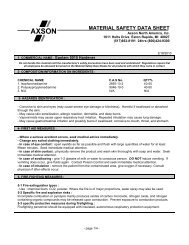MATERIAL SAFETY DATA SHEET - Axson North America, Inc
MATERIAL SAFETY DATA SHEET - Axson North America, Inc
MATERIAL SAFETY DATA SHEET - Axson North America, Inc
You also want an ePaper? Increase the reach of your titles
YUMPU automatically turns print PDFs into web optimized ePapers that Google loves.
<strong>MATERIAL</strong> <strong>SAFETY</strong> <strong>DATA</strong> <strong>SHEET</strong>AXSON NORTH AMERICA, <strong>Inc</strong>.1611 Hults Drive,Eaton Rapids, MI 48827 ‐ U.S.A.Tel. (517) 663‐8191Emergency Phone: 1‐800‐424‐93001- COMMERCIAL NAME : Epopast 206 NA Hardener8/10/2010Do not handle this material until the manufacturer's safety precautions have been read and understood! Regulations require thatall employees be educated & trained on the Material Safety Data Sheets for all products with which they come in contact.2- COMPOSITION/INFORMATION ON INGREDIENTS :CHEMICAL NAME C.A.S No. QTY%1. Isophorone diamine 2855-13-2 85-952. N/A N/A N/A3. N/A N/A N/A3- HAZARDS IDENTIFICATION :- Corrosive to skin and eyes (may cause severe eye damage or blindness). Harmful if swallowed or absorbedthrough the skin.- May cause skin sensitization, allergic reaction, dermatitis, and deep burns.- Vapors/mists may cause upper respiratory tract irritation. Repeated inhalation may cause lung damage.- May cause gastrointestinal irritation and possibly burns if swallowed; corrosive to mouth, throat, and stomach.4- FIRST AID MEASURES :- Where a serious accident occurs, seek medical advice immediately.- Change any soiled clothing immediately.- In case of eye contact : open eyelids as far as possible and flush with large quantities of water for at leastfifteen minutes. Seek immediate medical attention.- In case of skin contact : physically remove the product and wash skin thoroughly with soap and water. Seekimmediate medical attention.- In case of swallowing : give 1-2 glasses of milk or water to conscious person. DO NOT induce vomiting. Ifvomiting does occur, give fluids again. Contact Poison Control and seek immediate medical attention.- In case of inhalation : remove the patient from the contaminated area, give oxygen if necessary. Consultphysician if after-affects occur.5- FIRE-FIGHTING MEASURES :5-1 Fire-extinguisher types :- Use : chemical foam, CO2, powder. Where the fire is of major proportions, water spray may also be used.5-2 Specific fire and explosion risks :<strong>Inc</strong>omplete combustion or pyrolysis mainly produces oxides of carbon monoxide, nitrogen oxide, and nitrogencontaining organic compounds may be released upon combustion. Prevent exposure to combustion products.5-3 specific protective measures during firefighting :Firefighting personnel should be equipped with insulated, autonomous respiratory protection equipment.- page 1/4 -
COMMERCIAL NAME : Epopast 206 NA Hardener8/10/20106- ACCIDENTAL RELEASE MEASURES :6-1 Individual protection :Wearing of suitable protective clothing and protective equipment for face/eyes; wear suitable respiratoryequipment if ventilation is insufficient. Evacuate personnel from area.6-2 Environmental protection : Please see § 126-3 Decontamination procedures :- Contain spilt material in order to avoid its transfer to sewers or rivers and streams.- Physically remove the material. Evacuate personnel from area.- Cover material with sand, earth, or any other similar absorbent material in order to soak product up. Theresulting mix may then be shoveled into cans and removed for disposal (see §13).7- HANDLING AND STORAGE :7-1 Handling :- Inform personnel of risks associated with the product, the precautions to be taken and procedures to followwhere an accident occurs.- Observe personal hygiene rules to avoid contact with eyes and skin.- Avoid inhaling vapors produced by the material, especially when heated and/or sprayed.- Install showers and eye baths ("fountain" type).- Ensure sufficient ventilation, including appropriate local air extraction, in order to comply with workplaceexposure limits. Avoid breathing dust generated by machining.- Wash hands thoroughly at beginning of every work break and at the end of the working day.- Work stations and the general working area must be kept perfectly clean.- Avoid exposure to the product of persons having suffered from eczema or still suffering from any skincondition, wound, cut or irritation.7-2 Storage :- Keep the material hermetically sealed in its original packaging, protected from humidity and at a temperaturebetween 59 and 77°F / 15 and 25°C in a well-ventilated storage facility.- Ensure that the floor of the storage area is impermeable and concave in profile in order to provide effectivecontainment.- Keep the product away from food.- Reproduce labeling on all new packs where original packaging is divided.8- EXPOSURE CONTROLS/PERSONAL PROTECTION :8-1 Exposure controls :Always maintain workplace airborne contaminates to the lowest possible levels.8-2 Personal protection :- respiratory protection : NO, when vapors are below PEL recommendations. Recommended ifproduct is heated and/or sprayed.- eye protection : YES, safety glasses with side shields, or chemical-goggles and faceshield- skin protection : YES, protective gloves, such as nitrile, butyl, PVC, rubber, or neopreneDo not mix work clothing and normal clothing. Wash hands thoroughly at beginning of every work break and atthe end of the working day.- page 2/4 -
COMMERCIAL NAME : Epopast 206 NA Hardener8/10/20109- PHYSICAL AND CHEMICAL PROPERTIES :Physical state : LiquidColor : BlueOdor : characteristic (amine-like)pH : not establishedFlash point : > 240°F / 120°CDecomposition temperature : > 392°F / 200°CVOC content : no VOC's (0) for this productSpecific gravity : 0.97Solubility : in water - low; in solvents - YES (soluble in many organic solvents)10- STABILITY AND REACTIVITY :10-1 Dangerous decomposition by-products :- These are non-existent if storage and handling rules are followed (please see also § 5-2).- Carbon monoxide, carbon dioxide, ammonia when heated, nitric acid, and volatile amines during thermaldecomposition. Irritating and toxic fumes at elevated temperatures; nitric acid in a fire.10-2 Hazardous reactions with :- Do not place the product with nitrocellulose or halo hydrocarbon derivatives. Do not allow uncontrolledreactions with epoxy resins, acids, anhydrides, or chloride acid compounds - can create corrosive gas/vapors.11- TOXICOLOGICAL INFORMATION :Effects on eyes : Corrosive; may cause severe ocular irritation. Vapors may also cause eye irritation and pain.Effects on skin : Corrosive; a single short exposure may cause skin sensitization/burns; caustic effect on skinand mucous membranes. LD50 (rabbit): 1,840 mg/kg (Isophorone diamine)Inhalation : Excessive exposure may cause irritation and or burns to the upper respiratory tract. May lead tosensitization or respiratory system or asthma in predisposed individuals.Ingestion : May cause gastrointestinal irritation or ulceration. May cause burns of mouth, throat, and stomach.Swallowing will lead to a strong caustic effect on mouth and throat, and to the danger of perforation of theesophagus and/or stomach. LD50 (rat): 1,030 mg/kg (Isophorone diamine)12- ECOLOGICAL INFORMATION :Ecotoxicity : Slightly toxicEnvironmental fate : No dataAdditional information : waste from this product may present long term environmental hazards, thus landfilldisposal must be considered less acceptable than incineration.13- DISPOSAL CONSIDERATIONS :All disposal methods must be in compliance with all Federal, State/Provincial and local regulations. Regulationsmay very in different locations. Waste characteristics and compliance with applicable laws are the responsibilitysolely of the waste generator. Empty containers may not be disposed of unless any remaining material adheringto the internal walls has been removed (see § 6.3).- page 3/4 -
COMMERCIAL NAME : Epopast 206 NA Hardener8/10/201014- TRANSPORT INFORMATION :DOT Regulations/Information :Proper Shipping Name : Isophorone diamineHazard Class : 8UN/NA Number : UN2289Packaging Group : IIIInternal label : H226520015- REGULATORY INFORMATION :US Federal Regulation :Toxic Substances Control Act (TSCA) :All components are included in the EPA Toxic Substances Control Act Chemical Substance Inventory.OSHA Hazard Communication Standard Hazard Classes :Hazardous under the criteria of the Federal OSHA Hazard Communication Standard 29 CFR 1910.1200.Corrosive: Sensitizer: Harmful by skin absorption; Delayed Health Hazard; Immediate Health HazardOSHA PEL/TWA : none established for chemicals in this product.ACGIH TLV/TWA : none established for chemicals in this product.EPA SARA Title III Section 313 Toxic Chemicals : none16- OTHER INFORMATION :HMIS Ratings:Health. Flammability. Reactivity3.1.1.Ratings Key: 4 = Highest hazard, 0 = Lowest hazard, * = Chronic Health HazardREVEALING MODIFICATION : A3.PDFRevised : 8/10/2010 Supersedes sheet : 4/14/2006 This sheet provides a complement to the product use instructions but does not replacethem. The information it contains is based on our current knowledge of the product concerned at the date of drafting. That information isgiven in good faith and does not in any circumstances remove from the user his duty to be aware of and to follow all legal regulations andstatutes covering his activities. The user takes sole responsibility for application of safety measures covering the use of the product he isaware of. We also draw the user's attention to the risks attached to any use of the product for applications for which it was not designed.08/2010 Form GbA3.PDF New Logo- page 4/4 -



